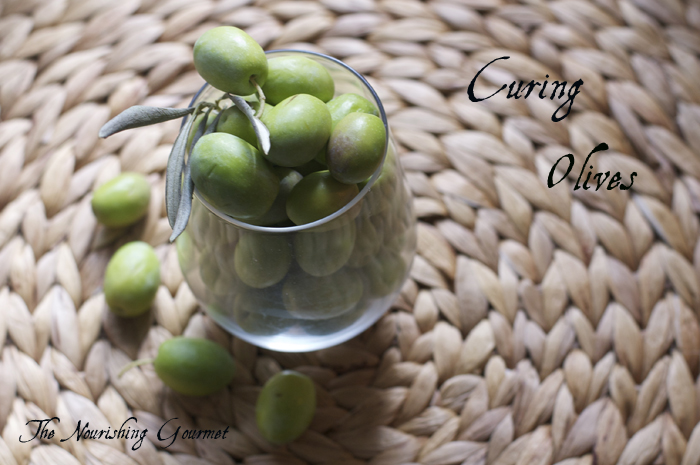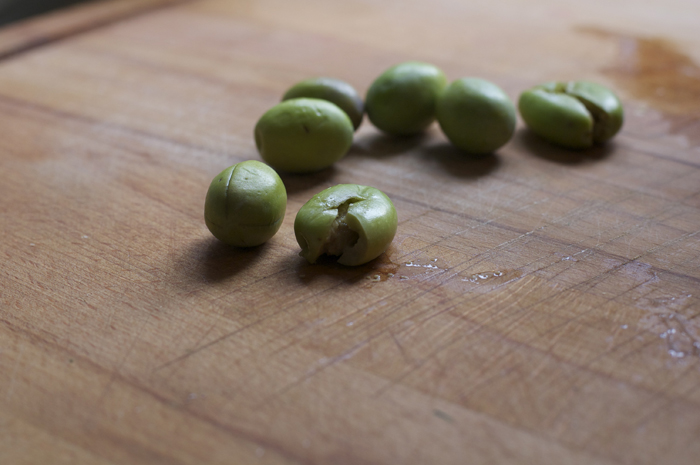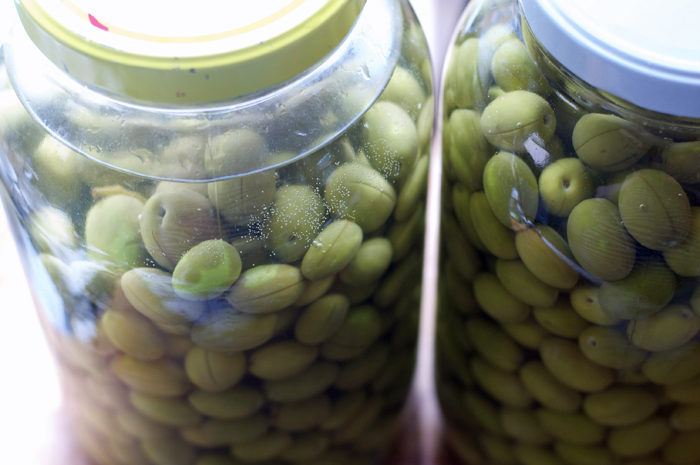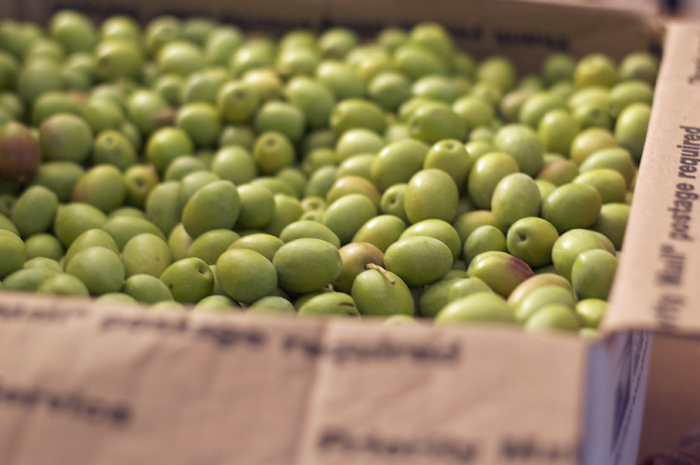 Sometimes the “slow food” way of life is…slow. I don’t if it’s simply natural impatience, or part of an ingrained heritage from the American life, but I rather enjoy instant gratification. What is that proverb again? All good things come to those who wait – I heard that more than once growing up. Well, curing your own olives is a simple procedure, but you do have to wait as they cure. Thankfully, good things do come to those who wait, and good olives are certainly worth waiting for.
Sometimes the “slow food” way of life is…slow. I don’t if it’s simply natural impatience, or part of an ingrained heritage from the American life, but I rather enjoy instant gratification. What is that proverb again? All good things come to those who wait – I heard that more than once growing up. Well, curing your own olives is a simple procedure, but you do have to wait as they cure. Thankfully, good things do come to those who wait, and good olives are certainly worth waiting for.
These bright green, beautiful olives come from Chaffin Orchards, kindly given to me to experiment with and blog about. (I believe later this month they will be selling black olives for home curers as well). These olives have a rich heritage and are grown in a mature grove on an organic farm. As Chaffin Orchards explain, “These olives for home curing are Barounis which come from our 50 year old majestic groves. Barouni olives are ideal for the home curer. They’re large green olives that ship well and are rather forgiving during the curing process. In fact they were originally planted nearly half a century ago for a farmer cooperative that was shipping olives to the east coast for folks interested in home curing. Being that olives only grow well in Mediterranean climates (no rain in the summer) and most people can’t get them in their locale’s we thought it only fitting to reopen that opportunity to people around the country to buy these wonderful olives and to create a new family tradition.”
My box of olives the day they arrived. So beautiful!
As I have started the process of curing these olives, two things have amazed me. The first is that someone at some time in history figured out how to cure olives. They are naturally quite bitter, which is why you have to cure them. Who saw beyond the bitterness of the olive and saw a delicacy? My hat is off to that person. The second thing that amazes me about the process is that you can cure olives with just water. A simple process of soaking the green olives in water, then draining and refilling is all that it takes to remove much of the bitterness. I am going to be using both the water cure (and then moving it to a brine), plus a brine cure.
 You can either “smash” the olive, or slice it several times before curing. This helps you leech out the bitterness.
You can either “smash” the olive, or slice it several times before curing. This helps you leech out the bitterness.
But the question is, why should you cure your own olives? Here are a couple of reasons I am plunging into this world.
1. I don’t like canned goods.
Canned goods generally have high amounts of BPA, which is dangerous as it is an endocrine disruptor, can mimic estrogen, and could be especially damaging to unborn babies. While some companies are removing BPA from the lining of their cans, some feel that there are still un-researched toxins in the lining of most canned goods. We still use some canned goods, but we try to limit it as much as possible.
2. Olives are really expensive.
We all love olives, but they are really an expensive food item, especially if you try to get some of the more “natural” canned or jarred olives. The gourmet “raw” olives have always looked so incredible to me….but I have never been able to fit it into our budget. Curing my own “raw” olives allows me to save money on a high-end product.
3. As I cure my olives, I am also attempting to help cure my instant gratification viewpoint towards food
I am so far removed from the farmers that are sure to be in my past history. I haven’t had to till, plant, water, tend, weed, harvest every vegetable and/or grain that is on my table. The fact is, my busy “modern” life has left me complaining at times about how much work getting a homemade dinner on the table is. But, when compared to my ancestors, my food came pretty darn easy. However, curing my own olives isn’t a self-punishment for my sometimes bad attitude! No, it is a cure because it helps bring just a little acknowledgement in my heart to the gift of food. And the more you are involved in the process of making food, the more pride (the good kind of pride) you feel when you share it with your family and your friends. It is good for me to get more involved sometimes. It is always good for me to be patient and grateful.
My olives are still in the first part of their curing process, so I am not going to share a personal recipe, but I thought I’d share some helpful links in case you too wanted to venture into the bright waters of olive curing.
 My olives during their “water cure”.
My olives during their “water cure”.
1. TLC Water Cured Green Olives: This basic recipe gives simple instructions for curing green olives.
2. This post at honest-food.com doesn’t give a recipe, but does give a lot of helpful information and tips. I have already referred to it several times.
3. The Lost Art of Curing Olives: Recipe and information
4. Wikihow.com, of course, also gives a great overview of the different methods
5. UOC shares a lot of really good information and recipes here as well (PDF)
Anyone else out there cure olives? I’d love to hear from you!
Latest posts by KimiHarris (see all)
- 2 Ingredient Peppermint Bark - December 21, 2022
- Herbal Hibiscus Lemonade (Keto, THM) - March 16, 2022
- Creamy Curry Red Lentil Soup - December 8, 2021

I also received a box of beautiful green olives from Chaffin Orchards and started water curing them almost 4 weeks ago. This is my first try so I’ve relied heavily on articles from the Internet. I read several recipes that suggested water curing for a week before adding spices, but I found that that wasn’t nearly long enough. I tasted them today and it looks like 4 weeks is going to be perfect. I also love how the color has changed and they look and smell like gourmet olives already! I’m excited about adding spices and allowing them to finish the long (but very satisfying) process. I’m even more excited about eating them when the long awaited day arrives!
Good for you! And I agree. One week just isn’t enough to remove enough of the bitterness from the olives. 🙂
We just bought six olive trees that already have fruit ready for the picking. This post is so timely! Time to gather supplies, harvest, and cure.
Lucky you! Enjoy those precious trees. 🙂
I will be interested in following your story. Curing olives has never come to mind, yet I love black olives; my husband likes green olives on his peanut butter sandwiches. And, of course, in our New Mexican Stockpot (made with chicken, potatoes, both Yukon Gold and Sweet) along with some other tasty veggies and green chilies.
I’ll let you all know how they turn out and which method I like best. 🙂
I’d also be interested in how this comes out! I’ve been eyeing the beautiful green olives at my local grocery store and have been wondering what I can do with them. I shall have to give curing a try.
That’s so cool that you can find uncured olives at your store! I’ve never seen them around here as our climate doesn’t allow them to grow well in the local area.
I also bought a box of olives from Chaffin! It’s funny, we were discussing the same thing, how in the world did someone figure out how to make olives edible?? Ours havebeen in water about 4 weeks and I’m getting ready to put them in brine. I cannot wait to taste the final products!
Me either! What brine are you going to use? I am considering trying two different types for my water cured olives.
I would really love to try this soon. Thank you for the resources!
Hi Kimi,
I’ve been trying to contact you through your contact form for the last few weeks, but I’m not sure if my emails are going through. I got your gmail address from my friend Caroline (she guest posted here) and sent you a message through that, but I got a delivery failure notice. I would love to guest post and would like to send you the application. What is the best way to contact you? Thanks!
Blessings,
Lauren
Thank you for elevating what people consider foods they can make at home. It is a pleasure to read your blog.
I am currently staying in a short term rental home in California, and it has a huge olive tree on the property, full of green olives! I would love to pick them and try this, but I was wondering if there is any way to know if they are “good enough” or the right kind? If the tree has just grown wild and not properly tended to as far as being used for olive production, do you think it is quality fruit? Might be worth a try anyways….thanks for the info!
Thanks for enlarging my world- I never even thought of curing olives! I can’t have most canned olives because the preservatives make me sick, so perhaps I will eat olives again! I’ll have to check out Chaffin Orchards…and check back to see how yours turn out.
Any updates? I’m curing some, too, but am only in the water stage. I hope to have them ready for Christmas gifts and wondered how yours turned out and how long you did the water vs brine! Any thoughts from your process would be so helpful! Thanks!
I picked about 50 kilos of olives from my trees in Turkey last October. I was advised to store them in water in containers till this year. I had hoped to take them to a wee local factory to be made into olive oil. However, a gardener has now told me that they cannot be made into olive oil as they have been in water
(Not salted). I have three questions, 1. Can they be made into oil or not? 2. Will they still be edible? 3. Can I now marinate them. And if so how long will they keep? Any answers would be massively appreciated. TIA